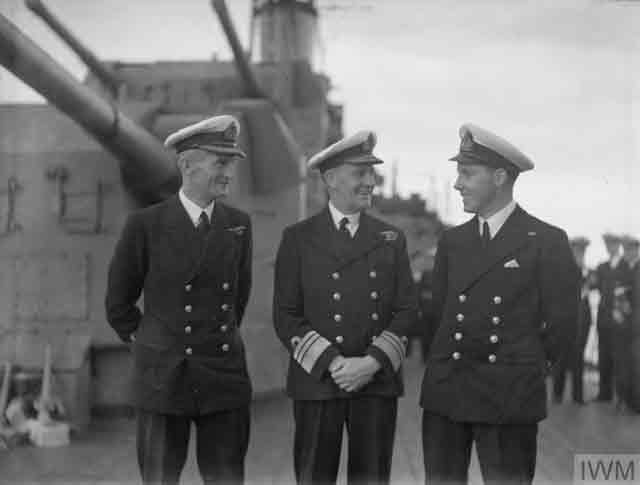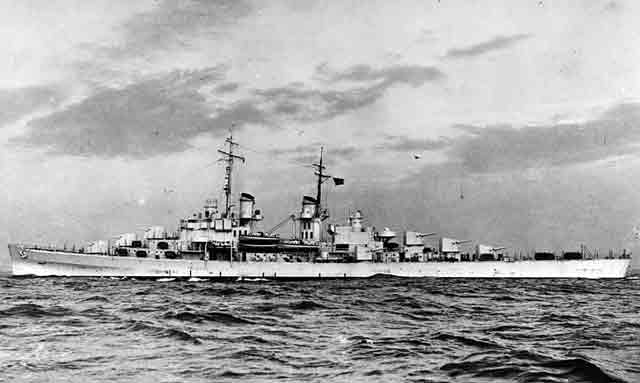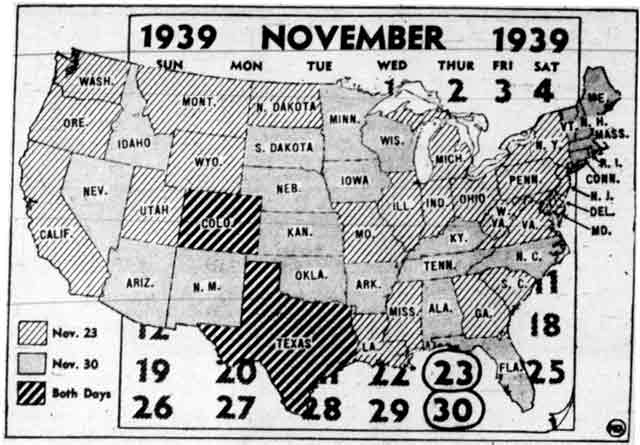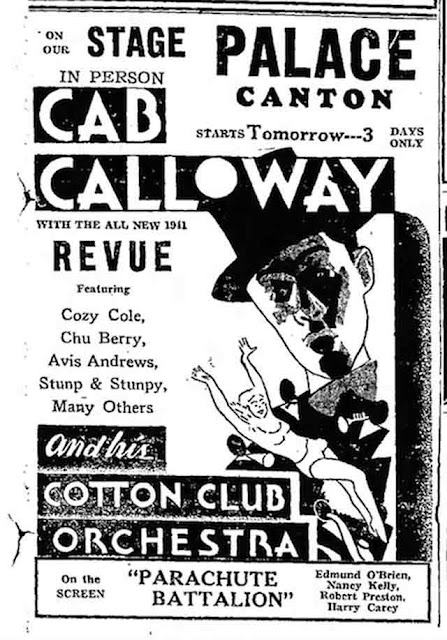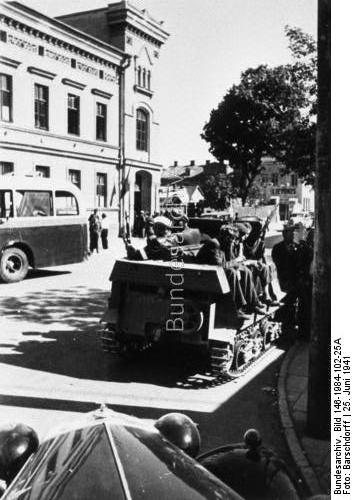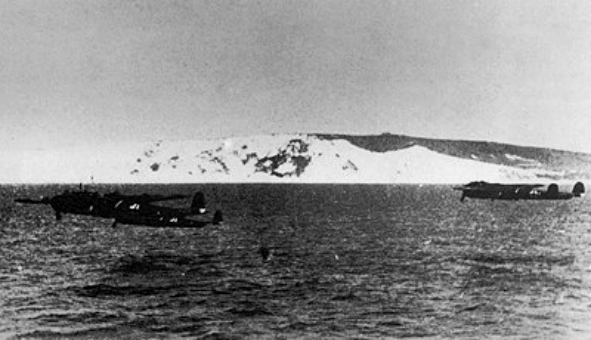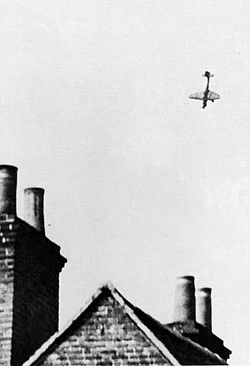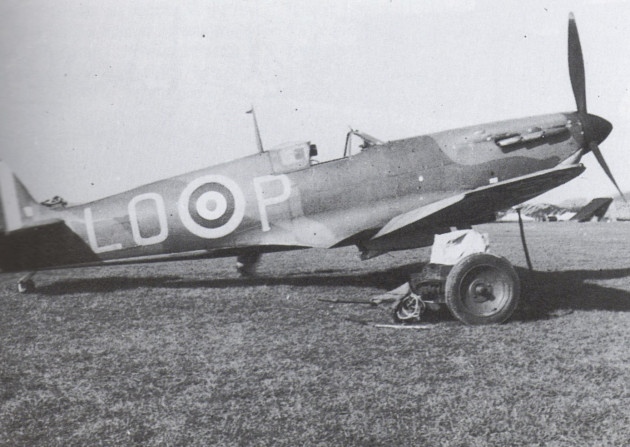Wednesday 25 June 1941
 |
| German pilots in Malmi, Helsinki on 25 June 1941. |
Eastern Front: The biggest news of 25 June 1941 includes Finland declaring war on the USSR and the Germans taking Dubno and Lutsk in Army Group South's sector and Baranovichi in the Army Group North sector.
Early in the morning, the Red Air Force bombs Helsinki, five other Finnish towns, and 19 airfields in Finland. The force includes 263 bombers and 224 fighter aircraft, bombing 15 cities, towns, and villages. Major targets include Helsinki, Kotka, Turku, Loviisa, Forsby, and Porvoo.
It is a massive Soviet effort that includes 460 planes. The Soviets lose 23-27 planes. In addition, the Soviets shell the Finnish positions on the island of Morgonland and other Baltic islands, some of which the Finns already have evacuated. The Soviets claim the airstrikes in Finland are aimed at German targets, as German forces are known to be operating from Finland.
There is another artillery duel between Finnish and Soviet forces at Hanko. These Soviet attacks are not accidents. Moscow radio broadcasts a threatening statement:
The Finnish militarists have flagrantly violated the Soviet-Finnish peace treaty. The rulers of Finland have begun military operations against our country . . . The Soviet Union has fulfilled the peace treaty conscientiously. But the rulers of Finland, under orders from Hitler, have plunged the long-suffering Finnish people into a war against the Soviet Union. Scoring the most elementary of international laws and the vital interests of their own people, the Finnish warmongers have again launched a campaign against the Soviet Union. . . . The ignoble rulers of Finland have not learned any lesson from the campaign of the winter of 1939 and 1940. They are asking for another, a final, lesson, and that lesson the Finnish perpetrators of fascism will get.
The Soviet statement is partly correct and partly false. While Finland has laid mines in the Baltic and allowed German troops to operate from its soil against the Soviet Union, Finland has not fired a shot against the Soviet Union since the Winter War. It has complied with the treaty that ended that war aside from the actions of its partner, Germany. So, both sides have an argument about who is in the wrong.
Most observers likely would agree, though, that allowing an enemy to freely use your territory to attack them (as Finland has done) is an act of war. So, the Soviets would have had the better case to declare war on Finland than vice versa - if they had done so, that is, and not simply attacked. Very few hands are completely clean on the Eastern Front.
Finnish Prime Minister Rangell had planned a speech to Parliament today regarding remaining neutral and taking only defensive measures. However, in light of the Red Air Force attacks, he quickly changes his speech to include a more bellicose tone:
Finland immediately declares war on the Soviet Union. This is done by the roundabout means of a simple unanimous vote of confidence in the present Finnish government. In fact, everyone "knows" that the Finns are German allies and preparing an attack of their own anyway. The Soviet air attacks, however, give the Finns a pretext for declaring war at once.
The Finns now grant the Germans permission to begin full-scale reconnaissance and carry out flights from Finnish territory. The Finnish IV Army Corps is granted permission to fire on available artillery targets, but for the time being, Finnish troops are not allowed to cross the frontier (that does not happen in force until July 10, 1941).
Finland has multiple military objectives, but the government fundamentally only has one goal: to recover territory lost during the Winter War. Finnish troops head toward Leningrad, the Svir River, and the Murmansk railway. This is known as the "Continuation War." While Finland is a "co-belligerent" of Germany, it is waging a completely separate campaign. While it coordinates operations with OKW, it does not take orders from Berlin and often disregards the German military's wishes.
The Finns do not attack at once upon the government's declaration of war, preferring to bide their time and pick a time and place that works with ally Germany. Instead, Finland's military continues mobilizing its forces and planning its axes of advance. The Soviets are too hard-pressed further south and actually withdraw forces from the border region with Finland around this time.
Operation Barbarossa continues moving eastward toward Leningrad, Moscow, and Kyiv. All of these operations are lumped together by the Russians as the "border defensive battles," which isn't particularly descriptive (understandable, since they don't go well for the Soviets). So, just for clarity and consistency, I use the names western sources have applied to events on the eastern front.
In the far North of Finland, the Soviets reinforce their defenses around Murmansk. With both England and the USA promising aid, the northern seaports have become vital elements of Soviet strategy and must be defended. The Germans are more interested in securing the nickel mines and plants along the border than attacking Murmansk at this time.
 |
| Panzer 38(t) tanks of Panzer Regiment 25, 7th Panzer Division, Vilnius, Eastern Front, June 1941. |
Army Group North under Field Marshal Ritter von Leeb is led forward by General Eric Hoepner's 4th Panzer Group. Following behind it are 16th and 18th Armies. In total, Army Group North controls 20 infantry, three panzer, and three motorized infantry divisions. Overhead, support is provided by Luftflotte 1 (the First Air Fleet). Kaunas and Vilnius have fallen, and the Soviets are retreating everywhere.
At the Battle of Raseiniai, which began on 23 June, the Germans of the 6th Panzer Division first encountered Soviet KV heavy tanks. One slipped through the German lines and proved impervious to the German anti-tank weapons. It has remained in place behind the lines, withstanding a pounding by 50-mm anti-tank guns and panzers in the vicinity. Early today, after almost two days, the Germans finally knock the KV out by bringing an 88 mm Flak gun through nearby woods and blasting the KV multiple times from the rear. The crew, incredibly, survives all this and only is killed by a pioneer engineer who climbs on the tank and pushes grenades through the holes made by the Flak gun.
As the day ends, the Soviet 8th Army is falling back to the Jonava about 48 km (30 miles) northeast of Kaunas, while the Soviet 11th Army is retreating toward the Desna. Marshal Semyon Timoshenko of the Stavka orders Front Commander Colonel General Vasily Kuznetsov to form a defensive line along the Western Dvina. Timoshenko releases the 21st Mechanized Corps (Major-General Dmitry Lelyushenko) with 98 tanks and 129 guns, from the Moscow Military District to help form this line.
 |
| The bridges at Dvinsk, 25 June 1941. |
After a successful surprise attack by elements of the 6th Panzer Division that captures two key bridges at Dvinsk during the early morning hours, the 8th Panzer Division captures Dvinsk. The bridges are wired for demolition, but the attack is so quick that the Soviets don't have time to blow them. The division then continues its northeastward advance toward Leningrad.
In Army Group Center, the Soviets launched a counterattack on the 24th toward Grodno. The attack, however, missed the leading German tanks of the 3rd Panzer Group, which already had driven further east to Vilnius. Today, the Soviet counterattack is crushed and the commander of Soviet 6th Cavalry Corps is taken captive. General Pavlov, in charge of Western Front, orders a general withdrawal to Slonim in order to block the way to Minsk. The Soviet 13th Army evacuates Maladzyechna, northwest of Minsk.
The Wehrmacht in the central sector has its eyes on a larger strategy than simply brushing off the Soviet counterattacks. General Hoth and General Guderian aim their panzer groups for a large-scale pincer move around the Soviet forces to the vicinity of Baranovichi.
In Army Group South, the Battle of Brody continues. This is a major tank battle, and along the front Soviet tanks outnumber the panzers 3229-728. However, in the most effective classes of tanks, the Germans have 355 with main guns of 50 mm or larger, while the Soviets only have 443 T-34s and KVs. So, while there is a great disparity in raw numbers, in fact, the destructive power of the respective forces is much more balanced from the raw numbers.
While it characterized as one continuous battle, the Battle of Brody actually is a series of disjointed Soviet tank charges against the advancing Wehrmacht. All these attacks do is grind down the Soviets' starting numerical advantage.
On the 24th, the Soviet 22nd Mechanized Corps attacks toward Voinitsa, Ukraine. It is making little progress and losing large numbers of tanks. The Soviets today move large numbers of tanks on a 500-km drive to the northwest of Brody, and, as the commander of the 8th Mechanized Corps, Ryabyshev, later writes, half of the tanks break down and the ones that make it are worn out. Some Soviet formations, such as the 15th Mechanized Corps, drive around following orders that are out of date and never even see the Germans.
Syrian/Lebanon Campaign: The Australian 25th Brigade at Jezzine has no success in its attempts to advance north through the mountains. The Australian commander falls ill and is replaced by Brigadier Plant, who favors using artillery and air power to wear out the defending Vichy French defenders rather than continue futile ground attacks.
Royal Navy submarine HMS Parthian at 12:12 torpedoes and sinks French submarine Souffleur off the Syrian coast.
 |
| German pioneer troops crossing a river in Russia, the morning of 25 June 1941 (Federal Archive Bild 146-1974-170-27). |
European Air Operations: During the day, the RAF sends Circus missions over France. In the first, RAF Bomber Command sends a force of Blenheim bombers under heavy fighter escort to northern France to attack the Hazebrouck marshaling yards. They cause widespread damage as an ammunition train explodes which includes the destruction of a bridge.
The other mission is to St. Omer, where the Luftwaffe has an important airfield. The elite German JG 26 fighter squadron is based at St. Omer, and they do not take kindly to being attacked. The Germans shoot down five Spitfires during the raid on Hazebrouck and lose at least two during the St. Omer raid. RAF ace Douglas Bader files claims for the two Luftwaffe planes, while Oblt. "Pip" Priller of I,/JG 26 claims a Spitfire over Gravelines.
RAF Bomber Command also attacks Bremen (64 bombers) and Kiel (47 bombers).
During the day, three Luftwaffe bombers are lost during an attack on Newcastle. It is unknown what happened to them.
The Luftwaffe sends some bombers to attack Southampton and the surrounding area. The Germans drop many parachute mines, each of which can destroy a row of houses. For the week ending at dawn on the 25th, the government reports that there were 39 killed and 116 seriously wounded, with no casualties in London.
 |
| New York Times, 25 June 1941. |
East African Campaign: General Wavell, still the Middle East Commander until Claude Auchinleck arrives from India, joins US observer Averell Harriman on an inspection tour of East Africa.
Battle of the Baltic: The Germans seize 1181-ton Estonian freighter Estonia in an Estonian port.
The Soviets sends cruiser Voroshilov from Sevastopol accompanied by destroyers to bombard Constanza.
 |
| A woman of the Finnish Lotta Svärd preparing for war, 1941. |
Battle of the Atlantic: The attacks on Convoy HX-133 continue south of Iceland. About ten U-boats are involved.
U-77 (Kptlt. Heinrich Schonder), on its first patrol out of Kiel and operating south of Cape Farewell, torpedoes and sinks 4603-ton Greek freighter Anna Bulgaris. Everyone perishes.
U-108 (Kptlt. Klaus Scholtz), on its third patrol out of Lorient, torpedoes and sinks two ships:
- 3059-ton Greek freighter Ellinico
- 4362-ton Greek freighter Nicholas Pateras
The entire crew of the Nicholas Pateras is lost (it is a straggler from Convoy OB-336), while everybody on Ellinico also perishes. That is the luck of the draw in the Battle of the Atlantic.
U-75 (Kptlt. Helmuth Ringelmann), on its second patrol out of Saint-Nazaire and south of Cape Farewell, torpedoes and sinks 1967-ton Dutch freighter Schie of Convoy OB-336. This sinking sometimes is listed as occurring on the 24th. Little is known about this incident, as there are no survivors (29 dead) and Ringelmaan cannot clearly identify the ship. It is simply assumed that U-75's victim is the Schie.
The Luftwaffe bombs and damages 2154-ton British freighter Dashwood east of Cromer. Everyone survives.
The Luftwaffe bombs and damages 176-ton British trawler Isle of Wight off Scarborough.
The Luftwaffe lightly damages Royal Navy destroyer Liddesdale in the North Sea. The ship remains in service.
Royal Navy minelayers Agamemnon and Menesheus lay minefield SN.70B off of Iceland. They have a heavy escort. It is a cloudy day, and destroyer Brighton runs into light cruiser Kenya on the starboard side. Both ships require repairs, and the Brighton loses its entire bow on the way under tow to the Clyde.
Minelayer Teviotbank lays minefield BS.65 in the North Sea.
The US Navy sends a squadron led by light cruisers Philadelphia and Savannah from Hampton Roads, Virginia on a neutrality patrol.
Canadian corvette HMCS Lethbridge (Lt. William Mahan) is commissioned, corvette Midland and minesweeper Medicine Hat are launched (in Midland, Ontario and Montreal, Quebec, respectively).
U-403 is commissioned.
 |
| Italian transport Neptunia. |
Battle of the Mediterranean: The RAF attacks Gazala and the Italian positions at Debra Tabor.
An Italian troopship convoy sets off from Naples bound for Tripoli. It is composed of transports Esperia, Marco Polo, Neptunia, and Oceania. Escorts include four destroyers (Aviere, Da Noli, Geniere, and Gioberti). British aircraft based on Malta attack the convoy. The British cause some light damage to transport Esperia but lose a Swordfish of RAF No. 830 when it crashes into the side of the Esperia.
During an air battle near Malta, Hurricane fighter pilots claim three Machhi 200 fighters shot down and an Italian bomber badly damaged. There are a couple of bombing raids on Malta that cause damage at Zeitun, Zabbar, and Safi.
 |
| German converted minelayer Adjutant. |
Battle of the Pacific: Captured Norwegian whaler Adjutant, sailing with a German prize crew, lays mines five kilometers off Lyttelton and Wellington (10 mines each), New Zealand. Nobody learns about this for many years.
POWs: French Lieutenant E. Boulé tries to escape from Colditz Castle POW Camp by dressing as a German woman. However, he drops his watch as he is walking away from the castle, and a German guard who goes to return it to "her" recognizes him.
 |
| Missionaries leaving Salt Lake Missionary Home, 25 June 1941. |
Anglo/Soviet Relations: The British send General Mason-MacFarlane by air for Moscow to head a military mission. This is a hazardous route that includes crossing occupied Norway and Finland. General Brian Horrocks replaces him in command of the 44th Infantry Division.
German/Soviet Relations: At some point during this week - details are very sketchy - Soviet Premier Joseph
Stalin attempts to broker a peace deal with Hitler through a Bulgarian diplomat, Ivan Stamenov. Foreign Minister Molotov has Lavrentiy Beria arrange this by using one of Beria's subordinates, NKVD officer Pavel Sudoplatov, who has a "casual" lunch at a Moscow restaurant with the diplomat. Sudoplatov explains to Stamenov what to say to Hitler. Stalin is willing to offer huge concessions for peace, including Ukraine and all of the areas granted to him in the "secret protocol" to the 23 August 1939 Molotov/Ribbentrop Pact in the Baltic States. Stalin does, though, demand to know why Hitler invaded the USSR.
Hitler turns Stalin down flat and will not even consider the offer. This is one of Hitler's biggest mistakes. These revelations were hidden for many years but came to light during the period after Stalin died from natural causes in the 1950s. There are few other details of this little-known incident, but there is no reason to doubt that it happened. This peace offer was classified as treason and was one of the charges used to condemn Beria to death. The others involved - including the Bulgarian Stamenov diplomat used as the go-between - submitted affidavits confirming the incident. Sudoplatov confessed to it under interrogation and also was convicted of treason, serving 15 full years in prison (yes, there are many questions about the validity of such "proof," but there was a lot of corroboration). Molotov was never tried for treason despite his deep role in the incident, but gradually fell out of favor, lost his positions one by one, and by 1962 was a "non-person" in the Soviet bureaucracy.German/Swedish Relations: With troops needed in Finland and no longer in Narvik, the Wehrmacht needs to move troops by train through neutral Sweden with the Swedish government's permission. This is the only quick route from northern Norway to the Baltic and a critical line - maintaining use of it is a top priority for the Wehrmacht in Scandinavia. The Swedish government (Riksdag) now permits the Wehrmacht to send one division at a time along the railway. The German 163rd Infantry Division (often called the Engelbrecht Division after its commander) begins to move its 15,000 troops, equipment, and supplies.
 |
| A Wehrmacht soldier allows two Finnish children to "ride" his motorcycle, June 1941. |
Japanese/Vichy French Relations: The Japanese desire military bases in southern Indochina and decide to use force if necessary to get them. The high command also sets 10 August as the deadline for a decision to attack the Soviet Union in conjunction with Operation Barbarossa. There are no plans to attack the USSR and no forces have been allocated for that purpose, but the Japanese do have a large military presence in China and Manchukuo which could be sent on an invasion.
German Military:
Reichsfuhrer-SS Heinrich Himmler and his adjutant, Joachim Peiper, embark on his headquarters train "Heinrich" for an inspection tour of the eastern front. Hitler's new headquarters in Rastenburg, the Wolf's Lair, conveniently is situated on a (closed) railway line, making visits to and from there by train very convenient for German leaders and foreign dignitaries.
US Government: President Roosevelt signs Executive Order 8802. This prohibits racial discrimination in the national defense industry, stating:
I do hereby declare that it is the duty of employers and of labor organizations... to provide for the full and equitable participation of all workers in defense industries, without discrimination because of race, creed, color, or national origin.
Roosevelt also creates the Fair Employment Practice Committee to implement the Executive Order. Along with some previous defense-related bills, these are key steps in the Civil Rights movement.
Holocaust: In Kaunas, political prisoners who have been released by the general uprising learn that Soviet security officers (some of whom reputedly are Jewish) are being held in the Lietukis car garage. They recognize some of their former captors. In a scene that will be repeated many times during World War II, the released prisoners kill the captive Soviets with blunt instruments.
More generally, local citizens engage in a rampage against Jews. This is known as the Kaunas pogrom. It is a sensitive topic, obviously, and there has been debate as to how much the recently arrived local German troops incite the locals to engage in anti-Semitic horror and how much is simply score-settling by locals (something that is quite common during World War II).
In any event, the pogrom lasts for five days. Jews are taken by locals to The Seventh Fort (or VII Fort, which is a defensive fortification built in Žaliakalnis district of Kaunas), one of many
ad hoc prisons outside the city, and imprisoned before their eventual fates. It is estimated that 10,000 Jews are beaten and then shot there by the end of July.
Anti-semitic activities also take place elsewhere in Lithuania. The events in Kaunas, however, are etched deeply into the memory of Lithuania.
 |
| Dr. Seuss - Hitler Taxidermist, published by PM Magazine on June 25, 1941, Dr. Seuss Collection, MSS 230. |
American Homefront: New York Yankee Joe DiMaggio gets a home run against St. Louis Browns pitcher Denny Galehouse in New York. This extends DiMaggio's club-record hitting streak to 37 games.
Isolationist Senator Robert Taft of Ohio gives a radio
speech in which he argues that the United States now is safer because of Germany's attack on Russia:
The Russian war certainly postpones for many months any attack which Hitler could possibly make; and makes even more certain a defense of the United States sufficient to discourage any military or naval attack.
Rather than declare war on anybody, Taft says that it would be wiser to avoid foreign wars and simply help England fight its war:
This country can be united on a policy of no intervention in Europe and aid to Britain. We can make that aid infinitely more effective if we abandon the role of world benefactor; if we leave Balkan politics alone; if we avoid a Communist alliance; if we adhere to the simple policy of aiding Britain.
He concludes, "The Russian war has weakened every argument for intervention." Roosevelt already, on the 24th, has promised aid to Russia to fight Germany.
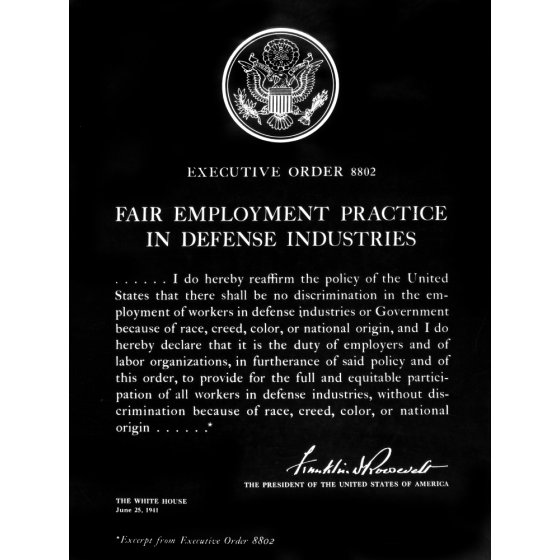 |
| President Roosevelt's "Fair Employment Practice in Defense Industries" Executive Order of 25 June 1941. |
June 1941 June 1, 1941: Farhud PogromJune 2, 1941: Massacres on CreteJune 3, 1941: Kandanos MassacreJune 4, 1941: Kaiser Wilhelm Passes AwayJune 5, 1941: Death in ChungkingJune 6, 1941: Hitler's Commissar OrderJune 7, 1941: Commandos Strike at PessacJune 8, 1941: British Invade Syria and LebanonJune 9, 1941: Litani River BattleJune 10, 1941: British Take AssabJune 11, 1941: Hitler Thinking Beyond RussiaJune 12, 1941: St. James AgreementJune 13, 1941: Lützow DamagedJune 14, 1941: Latvian June DeportationsJune 15, 1941: Operation BattleaxeJune 16, 1941: The Old LionJune 17, 1941: British Spanked in North AfricaJune 18, 1941: Turkey Turns Its BackJune 19, 1941: Cheerios IntroducedJune 20, 1941: Birth of US Army Air ForceJune 21, 1941: Damascus FallsJune 22, 1941: Germany Invades RussiaJune 23, 1941: A Soviet KV Tank Causes HavocJune 24, 1941: Kaunas and Vilnius FallJune 25, 1941: Finland Declares WarJune 26, 1941: Bombing of KassaJune 27, 1941: Encirclement At MinskJune 28, 1941: Minsk FallsJune 29, 1941: Brest Fortress FallsJune 30, 1941: Mölders Becomes Top Ace2020







